Learning Literature
We have watched with heavy hearts the waves of protest across the US and across the world. We can act, donate, work to be a better ally, but it’s okay too, to admit that while we have an understanding and we truly want to help, that we may not have the right words, or perhaps all the knowledge to do so effectively.
Roxane Gay has said often that empathy is expanded by literature. She says there has been “a dearth of stories about those of us who are, in some form or fashion, marked by difference.“
“It is, perhaps, no wonder that there has often been little empathy for those of us who are different. If no one knows our stories, how can they care about our lives?”
There has been debate in recent days about the framing of reading lists specifically highlighting antiracism. That, while well-intended, their messaging is incorrect: We shouldn’t be engaging with them impersonally, for the sole premise of education on antiracism. Instead, we should seek them out to further value the self-expression and diversity of experience of the authors.
However, in 2020, it can be argued that now, we need such lists to do both. The events of recent weeks alone have solidified the fact that white people have so much more to do when it comes to the fight against racism. Expanding our literary library, engaging with and reading the work of black authors; men and women who know what it is to live with racial injustice every day serves to inform, expand our empathy and know our place in this fight. Only through their stories, can we hope to better understand this struggle – which we all play a part in.
In our selection, we’ve also chosen the books, not because they solely tell us about antiracism (some specifically do), but also because they truly moved us. Because we need and want to hear their stories.
Because we love the words of the authors, how they deftly told devastating, moving and beautiful stories we are unable to forget.
Because we value the writers, their work, and the words they shared with us.
And while some of the titles aren’t directly about racial justice, they highlight what it means to be black in society today. All make for essential reading…
So You Want to Talk About Race by Ijeoma Oluo
For those who feel they don’t know how to start having these conversations, this is a fantastic resource about how to be honest and thoughtful in examining racism in the world, white people’s own role in it. It’s hard-hitting but accessible. Here, she underscores that our society is built on a systemic type of racism — one that leads to complicity in a racist system regardless of whether or not you want to be in that system. Such a book is never going to be an ‘easy’ read which is fitting because becoming a person who frequently engages in these conversations is far from easy. It is, however, essential we keep having them.
How to Be an Antiracist by Ibram X. Kendi
Ibram X. Kendi, an African American scholar spares no one from self-examination – himself included – as he uses his own life Queens, New York to confront and identify racism in America. Interweaving personal experience, he says those who believe they are not racists are antiracists, who support ideas and policies affirming that “the racial groups are equals in all their apparent differences — that there is nothing right or wrong with any racial group.” With chapters on power, culture, behaviour, colour, ethnicity and stereotyping he tries to reimagine society which might be free of racism one day but also is always working against it all the time. Powerful and necessary.
Why I’m No Longer Talking to White People About Race by Reni Eddo-Lodge.
Award-winning journalist Reni Eddo-Lodge turned a viral blog she published in 2014 titled Why I’m No Longer Talking to White People About Race into this award-winning eponymous book. In the blog, she expressed frustration with dealing with well-meaning but ultimately unhelpful white people and this is naturally expanded upon as she details in several essays, topics which deal with structural racism, class and feminism. It’s as relevant as ever.
To Kill A Mockingbird by Harper Lee.
When it comes to the books which taught us to lead by example as adults, for many To Kill A Mockingbird is one of the first we encountered which dealt with issues of race. The story details the racial troubles of the American Deep South in the 1930s and centres around dignified lawyer Atticus Finch and his young daughter, Scout, who serves as the first-person narrator throughout. The fact that it’s a beautifully crafted, Pulitzer Prize-winning literary classic is almost secondary here – its subject matter remains the most important, that of such prejudice and discrimination faced when a black man is accused of a crime against a white woman.
Finch counters the hatred in the community devoid of such prejudices all seen through the eyes of Scout and her brother Jem. This quote, a crucial piece of moral advice Finch gives to his daughter, sums up its importance, still, in 2020: “You never really understand a person until you consider things from his point of view . . . until you climb into his skin and walk around in it.”
Don’t Touch My Hair by Emma Dabiri.
The 2019 debut from the Irish-Nigerian author, academic, and broadcaster mixes the personal with the political in this riveting novel. Growing up in the mostly white Ireland of the 1980s, the writer’s hair and skin were constant topics of discussion by strangers. She wrestled with her identity, had hair that, in Ireland, people didn’t know what to do with. She went so far as to chemically straighten hers before cutting it off and growing it as she chose to – rather than what was the norm around her. And so she explores how, as a black woman, hair has always been a political issue, taking us on a journey from slavery to cultural appropriation and decolonisation. Read this, and pass it to everyone you know.
The Underground Railroad by Colson Whitehead.
This is the story of the unforgettable Cora, a slave on a cotton plantation in Georgia, who manages to escape a hellish existence via an underground railroad (which was, in reality, a series of safe houses and secret routes to help slaves get to Canada, but in the novel, it serves as an actual railroad in America). Her journey is long and harrowing as she seeks a life free from slavery. This isn't always easy to digest; it's dark and disturbing as each state she emerges into appears to present a new face of the horrors of slavery. But it’s overwhelmingly powerful in its message of hope. Part history, part human experience, this gripping, Pulitzer Prize-winning epic should be read by all.
Sing, Unburied, Sing by Jesmyn Ward
Thirteen-year-old Jojo is confused, angry and learning what it is to be a man. In Jesmyn Ward’s Sing, Unburied, Sing, he and his toddler sister, Kayla live with their grandparents, Mam and Pop. They await the return of their mother Leonie, fresh from another drug-induced bender. Then Jojo is stuck in a car; on a road trip as his mother and her drug buddy, Misty drive them to Mississippi State Penitentiary to see his father. This isn’t an ordinary story; it has ghostly undertones. When high, Leonie is haunted by her dead brother and Jojo communicates with the tortured spirit of a boy, Richie. Ward must look back at the pain of Black American history and its present hurt, while also overlooking both to tell this tale and she does so with brilliant poise.
Swing Time by Zadie Smith
In Zadie Smith's energetic Swing Time, it’s 1982 and an unnamed narrator meets Tracey, another brown girl in North West London arriving for dance class. Both dream of being dancers, but only one, Tracey, has true talent, while the other has ideas: ideas about music, black bodies and black dancing, and what it means to be free. Their ambitions take them off in different directions - Tracey makes it to the chorus line, but struggles as an adult, while her friend leaves their old life behind, travelling the world as an assistant to a famous singer. Smith beautifully uses the themes of music and dance to explore the complexities of race, culture, talent and friendship.
The Bluest Eye by Toni Morrison
The Nobel Prize-winner’s debut novel turns fifty this year and tells the story of an African American girl who equates beauty with whiteness. Pecola Breedlove longs for blue eyes. She’s eleven years old but has aged beyond her years with such sadness thanks to the abuse at home. She can only dream of those blue eyes – the eyes which will mean she can escape her blackness, her otherness. It’s a story of what she sees, of when she refuses to look or be seen by others. Over five decades old, it still has the same gut-wrenching impact, the book which paved a new path in the American literary landscape by asking powerful questions about race, class, and gender – with a young black girl at the heart of it.
join the conversation
share and comment below, we’d love to hear your thoughts…

























